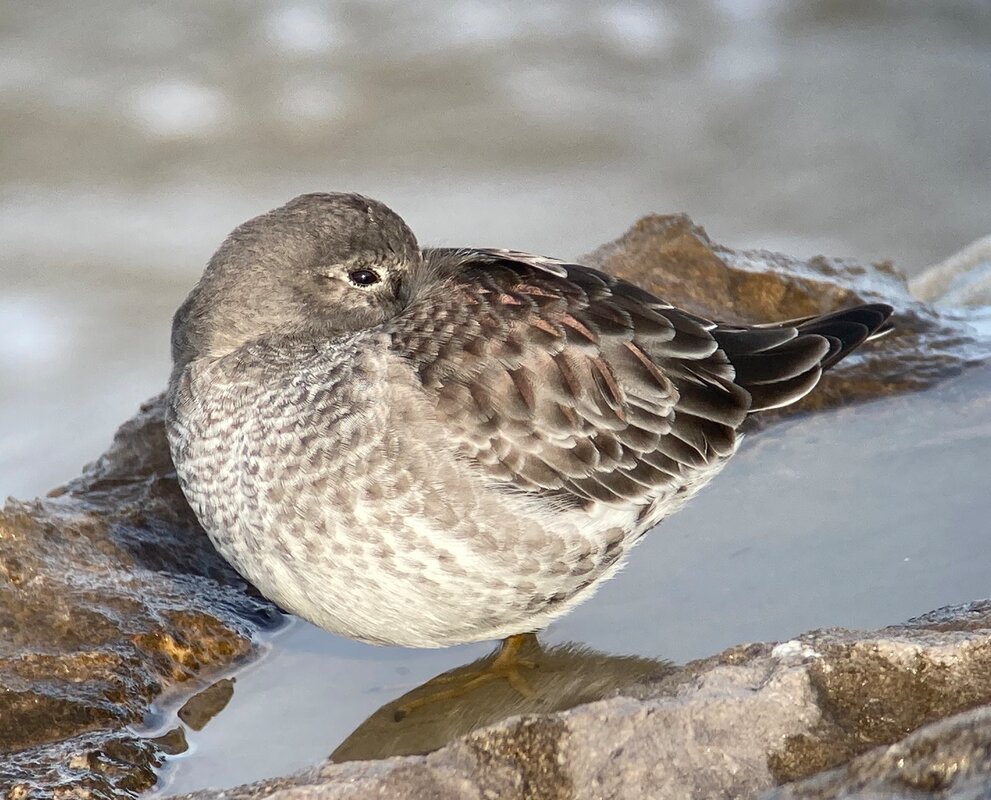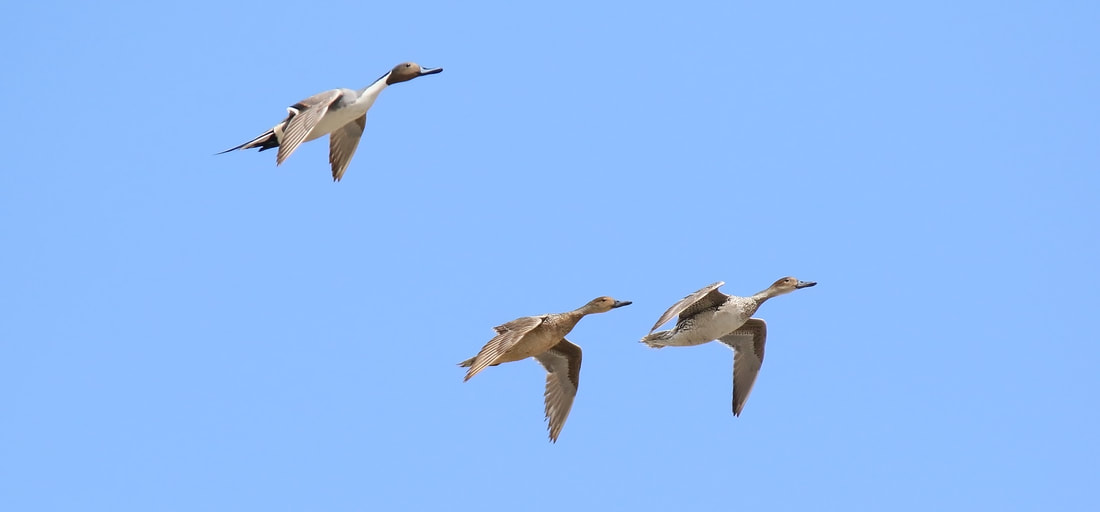|
One of the largest Starling flocks ever seen in North Wales has been recorded at RSPB Cors Ddyga in Anglesey’s Cefni Valley. Counting the number of birds in the shape-shifting murmuration in the half-light of dusk is challenging, but estimates from experienced birdwatchers at the weekend varied between 750,000 and 1.5 million. The largest flock on the island was an estimated one million birds at Llyn Traffwll in 1983, and the most ever seen in Wales was a roost of 1.5 million in Glamorgan in the 1960s, so it’s spectacular in size as well as shape.
Many will have bred around the Baltic Sea, as demonstrated by one that had been ringed in Lithuania in summer 2015 and was among the hundreds found dead on a road near Bodedern last December. The Cors Ddyga roost has attracted the interest of hunting raptors, with Sparrowhawk, Merlin and Peregrine swooping in to catch a late meal. Snow Buntings brought some wintry sparkle to local beaches, with four at Holyhead and singles on the coast path at Kinmel Bay, Cemlyn beach, Llandudno’s West Shore and Morfa Madryn nature reserve near Llanfairfechan. An Iceland Gull flew over Bangor Pier and 10 Whooper Swans over Queensferry on Friday. Three Long-tailed Ducks were off Benllech last week, two are in Y Foryd and one on Anglesey’s Inland Sea. Also offshore are two Velvet Scoters off Dinas Dinlle and 24 Great Northern Divers off Aberdesach. Black Redstarts have been at several locations in the last week, including at sites where they have overwintered previously. Two are at Amlwch Port’s old Octel works and others at Bangor’s university Ffriddoedd Halls, Holyhead breakwater, near Trearddur Bay and on Gwynedd Council offices in Caernarfon. A late Swallow was at Rhostryfan on 28 November – will it be the last of the year?
2 Comments
Here’s a challenge for the celebrities at Gwrych Castle. Get from Arctic Canada to North Wales, using nothing but your own energy and limbs. You’re allowed to rest en route, but you must do the last leg from Iceland without stopping. When you arrive, you deserve a good kip. But you must sleep standing in a pool of water that is just a few degrees above freezing. Your bushtucker trial is to find enough worms, seaweed flies and molluscs every day to survive for the next four months. Then make the journey in reverse.
Who is King of the (Sand) Castle now…? A Purple Sandpiper, I’d say, though they prefer rocky coasts to sandy beaches. Four of these little waders are at Rhos Point, retaining a few of the shiny feathers that provide their name. Other Arctic arrivals include Whooper Swans, at Beddmanarch Bay and over Llandudno, and Snow Buntings: five at Holyhead breakwater, two at Point of Ayr and two at Kinmel Bay. A single Snow Bunting at Llandudno’s West Shore was replaced on Saturday by a Lapland Bunting. A skein of Pink-footed Geese flew over the Little Orme on Monday, while Greenland White-fronted Geese are benefiting from extra legal protection since the Welsh Government banned hunting of these rare visitors this year. A flock of 18 was at RSPB Cors Ddyga, two near Pentraeth and two flew over the Great Orme. Anglesey’s Inland Sea hosts a Long-tailed Duck, four Great Northern Divers, seven Scaup and a Slavonian Grebe, while a couple of Velvet Scoters are among a huge flock of Common Scoters off Old Colwyn. Raptors hunting for food in the limited daylight hours include Short-eared Owls at Amlwch, Conwy golf course and at RSPB Cors Ddyga, where a Merlin and a Hen Harrier were also seen over the weekend. Small numbers of Scaup, an Arctic nesting duck that looks superficially similar to our more abundant Tufted Duck, spend the winter in Britain, and the first of autumn have appeared in Anglesey this week: two at RSPB Valley Wetlands and six on the Inland Sea. The latter site also hosts several Great Northern Divers, including one with a broken bill that has returned for at least its third winter, showing that it can feed effectively despite missing half its lower mandible. Little is really known about the wintering habits of these chunky waterbirds, known as Common Loon in North America, but this one clearly likes the sheltered shallow waters east of Holy Island. Another six were off Porth Ysgaden, one in Holyhead harbour and one fished crabs from the Afon Glaslyn near Porthmadog, Nearby, the first 11 Whooper Swans have arrived for the winter.
Five Great White Egrets remain together near Llanerchymedd, another was on the Mawddach estuary near Penmaenpool, and a Cattle Egret was on the Rhyl bank of the Clwyd estuary. At the other end of the scale, tiny Firecrests were at Morfa Madryn, Menai Bridge’s Church Island and in a Hawarden garden. Several Snow Buntings were found on beaches in the region, including two each at Holyhead breakwater, Point of Ayr and Kinmel Bay, and singles at Llanddona and Llandudno’s West Shore. North Anglesey’s long-staying Rose-coloured Starling fed in an Amlwch Port garden at the weekend. Eight Spotted Redshanks are wintering at Connah’s Quay nature reserve, by far the most reliable site in the region for this wader, with another couple at RSPB Conwy. Three Purple Sandpipers rested on boulders at Rhos Point at high tide, seven at Trearddur Bay and an impressive 22 at Trwyn, near Cemlyn. A late Wheatear remained on the Great Orme on Saturday. Join me and Mike Raine for the first in a new series of ‘Day in the Life…’ Q&A sessions on Mike's Notes from the Hill Facebook page this Wednesday (18 November) at 6pm. With the ‘firebreak’ lockdown ending on a day of fine late autumn weather, I spent Monday on Anglesey, watching the incoming tide pushing hundreds of Pintails close to Malltraeth Cob. It’s always been one of my favourite places to watch these elegant ducks with its long central tail feather that looks as though it has been waxed to a fine point by Salvador Dali’s barber. Pintails are global travellers, some moving from the Arctic Circle to West Africa. Ringed birds have been found in Wales from Estonia and one ringed in Wales was subsequently found in Iceland. North Wales is an important wintering area for Pintails: the Dee Estuary regularly holds more than 10% of the northwest European wintering population, and the upstream Dee flood meadows and Traeth Bach near Porthmadog are nationally-important too.
Over the weekend, six Great White Egrets were in fields east of Llyn Alaw and others near Trefnant and Llanfairfechan. Whooper Swans were seen arriving from Iceland at several sites, including 13 on Anglesey’s Inland Sea, three tracked by birders along the coast from the Little Orme to Cors Goch, and the first of the winter on their regular wintering fields near Llanerchymedd. Most wader migration is over, but a Grey Phalarope fed briefly in the surf near Colwyn Bay’s new pier and a Spotted Redshank was ‘heard’ overnight by recording equipment over a Penrhyn Bay garden. The first Woodcocks arrived at the weekend too. With no golfers on Conwy golf course, a Short-eared Owl hunted the rough and at least one quartered over saltmarsh west of Llanfairfechan, though a second bird was found dead there last week. A couple of Black Redstarts are in northeast Anglesey and another was at Uwchmynydd, while late summer migrants include a Wheatear on the Great Orme and a Swallow at Foryd Bay. It’s the time of year that flocks of small songbirds are forming. Blue, Great and Long-tailed Tits are sometimes joined by tiny Goldcrests or a Chiffchaff, but occasionally something rarer. Firecrests were at Bangor Mountain, RSPB Conwy, South Stack, on the Great Orme and at Gloddaeth Woods near Llandudno. Yellow-browed Warblers were on the Little Orme, Great Orme, near Bangor Pier, Benllech and Llanddona. A late Ring Ouzel was on Anglesey’s Mynydd Bodafon, two Great White Egrets from Porthmadog Cob, a Long-tailed Duck at Malltraeth Cob and a Hooded Crow was over Bangor. A Rose-coloured Starling was at Llanbedr airfield, a leftover from the summer’s irruption from southeastern Europe.
A few late Swallows have been reported this week, but early November sees the arrival of migrants from the north. Thousands of Chaffinches were reported from coastal watchpoints, with a few dozen Bramblings, plus Siskins, Coal Tits and Lapland Buntings. A Snow Bunting was at Holyhead’s Soldier’s Point, but more unusual was a Treecreeper, only the second recorded there by local birder Ken Croft in 46 years. Treecreepers were also recorded at the tree-less end of the Great Orme. I wonder how far they had come? Most Treecreepers barely move during their whole life, but ringing shows that young birds will travel up to 200km in their first autumn. Ringing also shows the different lives that birds lead. Two Little Egrets ringed near Bangor by the Mid Wales Ringing Group in 2012 are a good example. One has been seen regularly at RSPB Cors Ddyga on Anglesey in the eight years since. Its neighbour was seen in Lanzarote in 2014 and again in March 2020, but was recently photographed in South Wales. At over 2,800km, it’s one of the longest movements ever made by a British Little Egret. Has it been making that commute annually? |
Bird notesA weekly update of bird sightings and news from North Wales, published in The Daily Post every Thursday. Archives
July 2024
Categories |





 RSS Feed
RSS Feed
